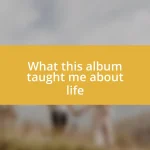Key takeaways:
- Drama has evolved to reflect societal changes, emphasizing raw character flaws and complex narratives that resonate emotionally with audiences.
- Current trends in drama include a focus on mental health, globalization of narratives, and blending genres, enriching storytelling and viewer engagement.
- Feedback and adaptability are crucial for growth as a creator, enhancing character development and emphasizing emotional authenticity in narratives.
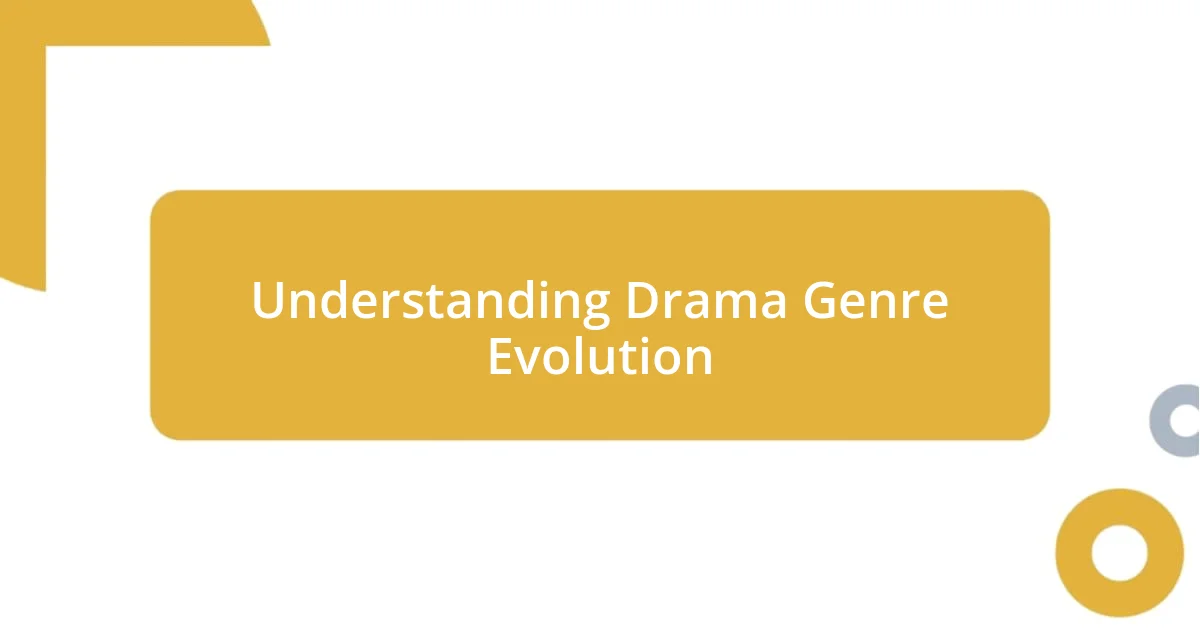
Understanding Drama Genre Evolution
Drama has evolved dramatically over the decades, often reflecting the societal changes of its time. I remember watching a classic drama where the struggles of characters were tied to post-war issues, and I couldn’t help but think about how relatable their pain felt even in today’s context. Doesn’t it make you wonder how our current events will influence future dramas?
These genre shifts often occur because creators are responding not just to changes in society, but also to the audience’s evolving tastes. I distinctly recall a wave of shows that took on a more raw and unfiltered approach to storytelling. Wasn’t it refreshing to see characters with flaws laid bare—a stark contrast to the more polished heroes of previous eras?
Exploring these shifts sheds light on how emotions portrayed on screen can resonate with our own life experiences. I find that the darker, more complex narratives emerging now allow for deeper connections, don’t you think? It’s as if each new genre isn’t just a new label but a pathway into understanding our own humanity better.
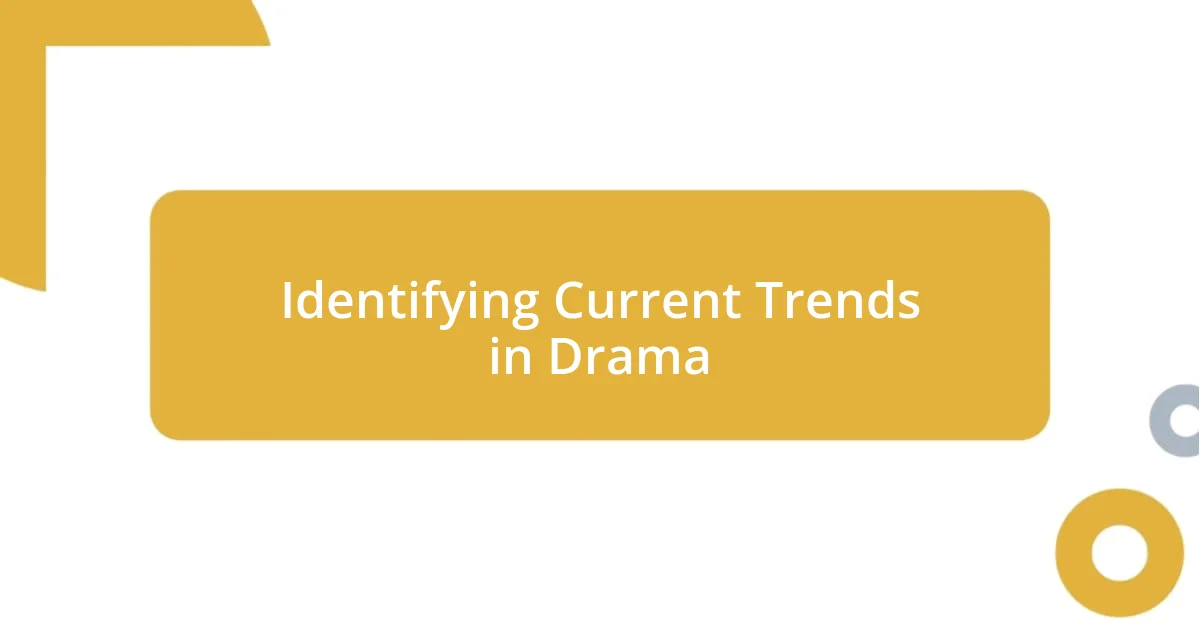
Identifying Current Trends in Drama
Identifying current trends in drama reveals a fascinating tapestry of storytelling that’s shifting to meet the times. I’ve noticed a significant rise in narratives centered around mental health, reflecting a broader societal discourse that’s become more open and accepting. I recall a particular show that tackled anxiety through the lens of a charming protagonist, making the topic feel approachable and relatable. Isn’t it remarkable how these stories can normalize conversations we’ve long avoided?
Moreover, the globalization of drama has brought diverse narratives to the forefront. I vividly remember the first time I watched a foreign drama series that tackled themes of family bonds in ways I hadn’t seen before. It broadened my understanding of cultural nuances and made me appreciate the universal truths thread through different lifestyles. This exchange of ideas has enriched our viewing experiences—don’t you see it too?
Lastly, the trend of blending genres has produced some of the most engaging content I’ve experienced. I reflect on a recent series that married drama with dark comedy, a delightful mix that kept me on my toes. This hybrid approach not only entertains but also allows for complex character development, making the stories more immersive. Isn’t it exciting to witness how these trends can push the boundaries of traditional drama?
| Trend | Description |
|---|---|
| Mental Health Narratives | Focus on mental health issues, promoting open dialogue and understanding. |
| Globalization | Diverse cultural perspectives enriching storytelling and audience experiences. |
| Blended Genres | Combining elements from different genres like drama and comedy for innovative storytelling. |

Assessing Personal Style and Skills
Assessing my personal style and skills in adapting to changing drama genres is both a reflective and enlightening process. I often find myself examining what draws me to a particular narrative style or theme. For instance, my appreciation for character-driven stories stems from my own experiences where I’ve often found relatable struggles mirrored on screen. This connection deepens my investment in the storytelling, and I’ve realized that acknowledging my emotional responses helps me navigate through diverse genres more adeptly.
-
Visual Aesthetics: I tend to gravitate towards visually rich dramas that create a certain atmosphere. Beautiful cinematography can elevate even the most basic storyline.
-
Emotional Resonance: I’ve discovered that I respond strongly to narratives that evoke genuine feelings. When a show or film makes me laugh or cry, it stays with me long after the credits roll.
-
Character Complexity: I value layered characters with depth. The more flawed and human they are, the more I feel connected to their journeys, which often leads me to thematically complex genres.
-
Cultural Context: I embrace stories that explore different cultures. My own curiosity about the world and different lifestyles makes me appreciate how diverse narratives can reshape my understanding and empathy.
By assessing these personal elements, I enhance my ability to not only adapt to shifting genres, but also to engage with them on a deeper level. It’s an ongoing journey of aligning my tastes with the evolving landscape of drama.
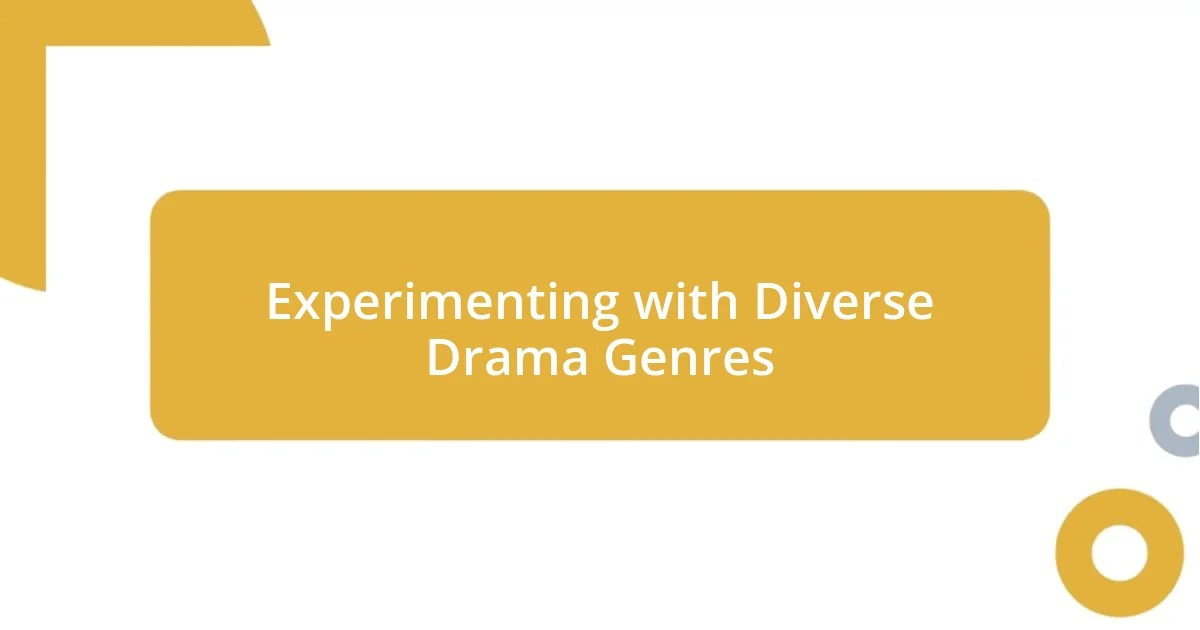
Experimenting with Diverse Drama Genres
Experimenting with diverse drama genres has been a thrilling aspect of my viewing journey. I remember diving into a sci-fi drama that intertwined social issues with speculative technology. Initially, I felt hesitant—would I connect with such a futuristic narrative? But as the characters grappled with dilemmas that mirrored today’s struggles, I found myself captivated. It’s awe-inspiring how genre-bending can create a dialogue about present-day realities.
As I embrace variety, I often stumble upon genres that surprise me. For instance, I never thought I’d be so enthralled by a historical drama that unfolded during a tumultuous period in history. The way the writers humanized figures from the past, illustrating their fears and ambitions, made me rethink what I knew about that era. Have you ever watched something that changed your perspective entirely? It’s moments like these that remind me why I love pushing genre boundaries.
I also see experimenting with genres as an opportunity for growth. Trying my hand at melodrama, for example, taught me about expressing vulnerability. I used to shy away from stories that drew tears from me, thinking of it as a weakness. Now, I embrace those emotions, recognizing they enrich my experience and understanding of the human condition. Isn’t it remarkable how stepping out of our comfort zones can lead us to newfound appreciation?

Creating Flexible Character Development
Creating flexible character development can truly transform a narrative, allowing characters to grow alongside evolving genres. I remember a time when I was engrossed in a romance that unexpectedly shifted into a thriller. The characters I had initially viewed through a romantic lens suddenly became more complex, revealing hidden facets of their personalities. Have you ever found yourself rooting for someone, only to discover a darker side? That twist gave me a fresh perspective on character depth.
To foster adaptability in character development, I often focus on the motivations driving each character’s actions. For example, in a drama steeped in cultural heritage, I crafted a character who faced familial pressures while pursuing her dreams. This tension not only made her relatable but also showcased how personal conflicts can manifest in diverse genres. Isn’t it fascinating to see how our own experiences influence the characters we create or connect with?
Moreover, I’ve learned that the emotional arcs of characters should reflect the shifting tones within a narrative. By allowing characters to transition from light-hearted to serious, I can mirror the genre changes right on the screen. I once wrote a screenplay where a comedic character developed a tragic backstory, and that seamless transition added depth and authenticity to the story. How do you think audiences react when a once-funny character faces serious trials? In my experience, it pulls them in, making the journey all the more engaging.
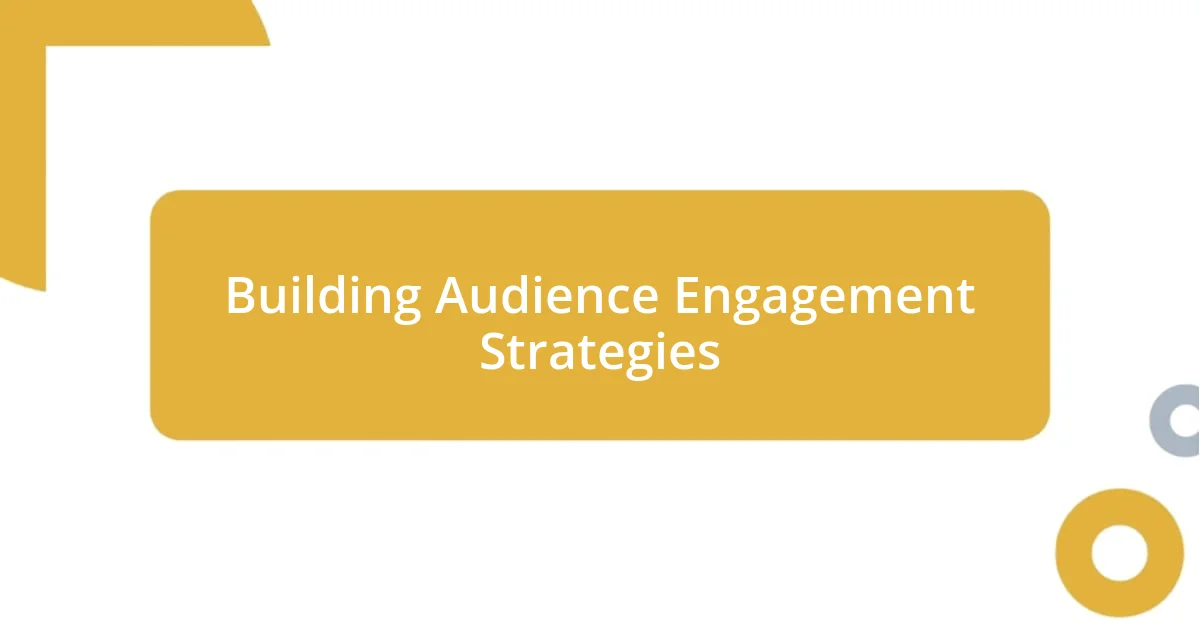
Building Audience Engagement Strategies
Building audience engagement strategies can be incredibly rewarding when I truly understand what resonates with viewers. I recall a time when I hosted a film screening where I encouraged everyone to share their thoughts afterward. The lively discussions that followed not only enhanced the experience but also created a sense of community among participants. Isn’t it amazing how a simple conversation can deepen our connection to the content we’re watching?
Another tactic I find useful is integrating interactive elements into storytelling. For instance, I experimented with social media polls during a mini-series release, allowing viewers to vote on potential plot twists. The feedback not only made my audience feel valued but also sparked excitement about upcoming episodes. Have you ever felt more invested in a story just because you had a say in its direction?
Additionally, analyzing viewer feedback has been pivotal in my approach to engagement. By identifying common themes or preferences, I can tailor content that speaks directly to my audience’s interests. There was a project where I tweaked character arcs based on viewer comments, which led to a surprising uptick in viewership. How do you think data-informed decisions shape storytelling in today’s dramatic landscape? From my experience, they can lead to more compelling narratives that keep audiences coming back for more.
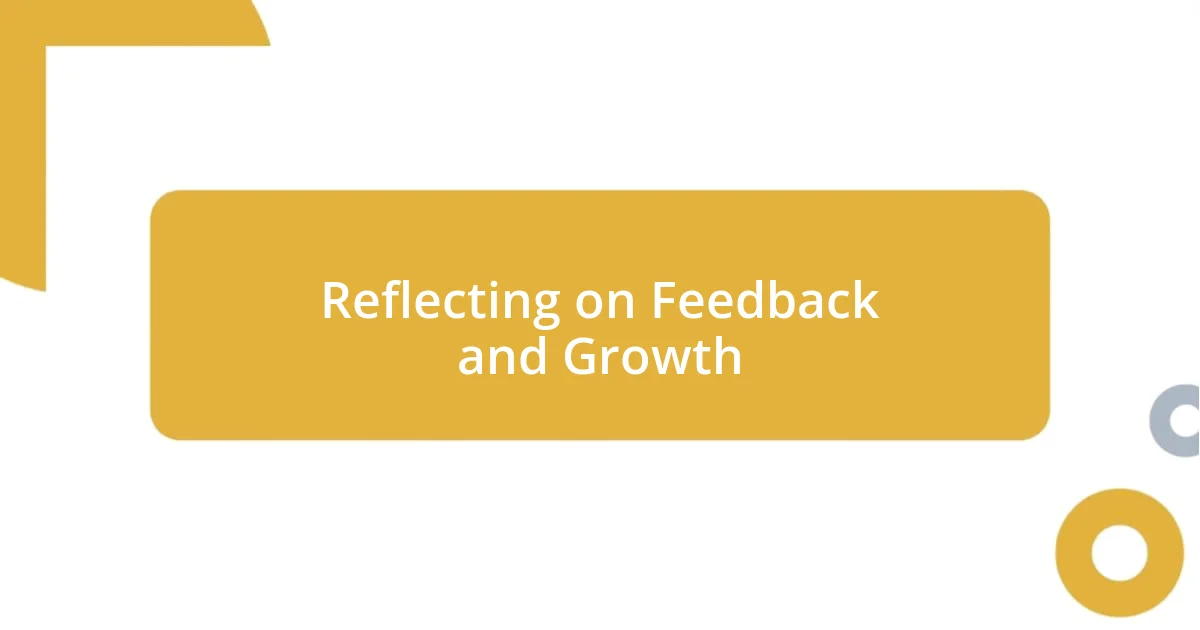
Reflecting on Feedback and Growth
Feedback in the realm of drama has always been a critical piece of my growth as a creator. I remember a project where audiences were confused by a character’s sudden shift in behavior. At first, I thought I’d nailed it, but the feedback opened my eyes to the fact that, without clear motivations, even the best ideas can fall flat. Isn’t it interesting how other people’s perceptions can shine a light on our blind spots?
Listening to constructive criticism has not only refined my writing but also deepened my understanding of emotional authenticity. There was a time when a close friend told me that a scene I thought was powerful felt forced. It stung, initially, but after reflecting on their perspective, I realized I hadn’t fully developed the emotional connection between characters. Have you ever had a moment when another person’s insight changed your viewpoint entirely? I found that a willingness to adapt based on feedback can lead to authentic character relationships that truly resonate.
Having a growth mindset has allowed me to pivot my storytelling approach. I often revisit scripts after receiving feedback, seeing them with fresh eyes and applying the insights I’ve gained. One script in particular transformed significantly after I incorporated audience input on pacing. Instead of remaining stubbornly attached to my original vision, I embraced those changes, which resulted in a more cohesive and engaging narrative. How often do we limit ourselves by clinging too tightly to our ideas? In my experience, stepping back and allowing for growth makes all the difference in crafting compelling drama.





